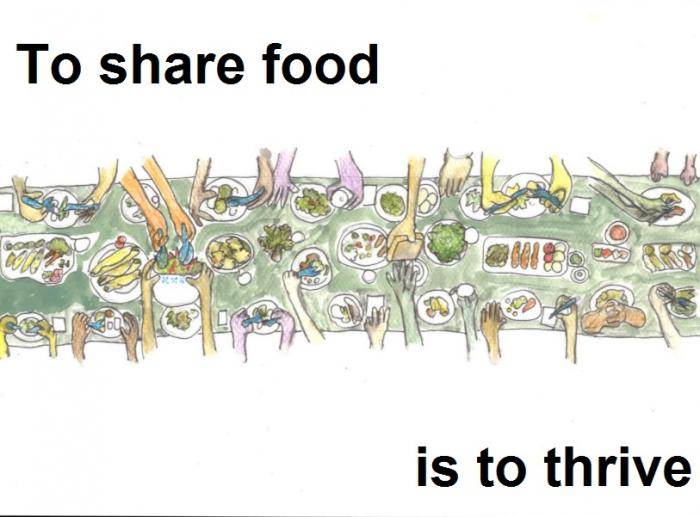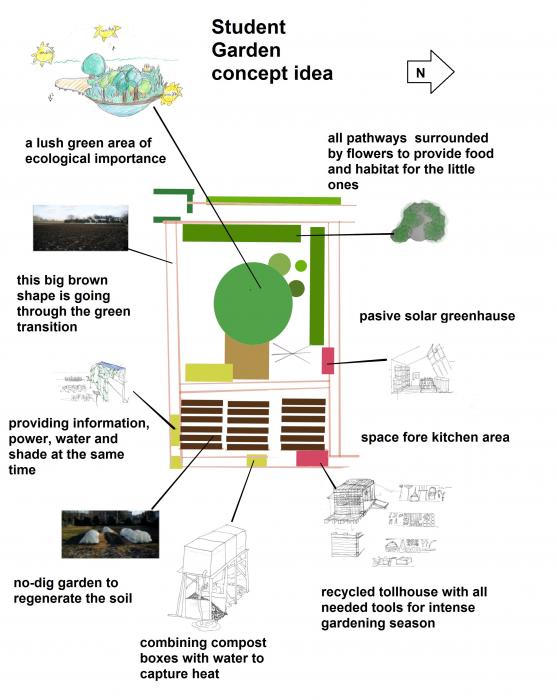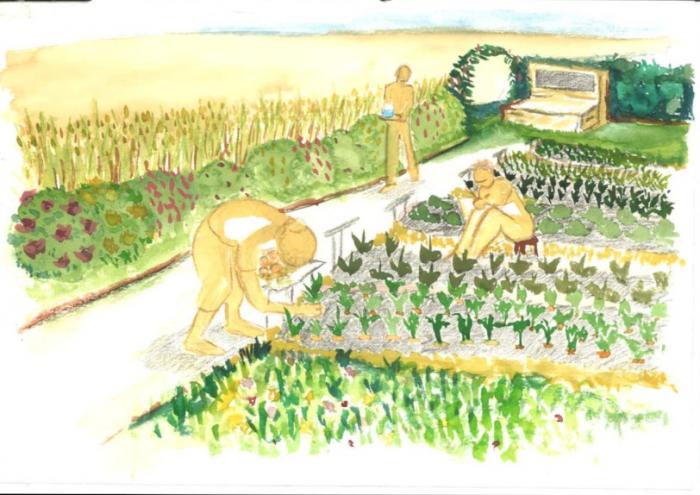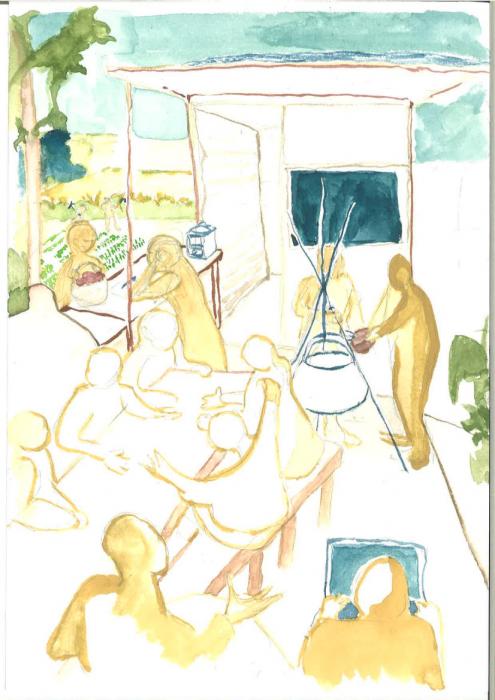The Student Garden is a place where nature and man meet, a place of an inexhaustible source of creativity and change. By taking care of the garden, students create a community of young people who carefully include and respect every element of the environment that surrounds us. From seed to fruit, from curiosity to experience and from an idea to reality. The Student Garden initiative regenerates soil and minds, learns about food, sustainability, nature and man.
We have recognized the need for developing agroecology in our country as it is a crucial element in the green transition of our societies. Our goal is to create a space to study and research methods and practices used in sustainable food systems by embracing uncertainty and learning by doing.
The Faculty of Agriculture in Zagreb is one of the leading institutions for scientific research of agroecology in Croatia and can considerably contribute to this project started by its students. The faculty provided a trial area for students to use as a garden. The Student Garden initiative wants to accumulate and then spread knowledge about food sovereignty beyond academia, to the farmers and citizens by embracing the living-lab model. By being proactive youth, we are steering our agency towards openness and creativity, contemplating new ways of engaging with our surroundings.
Our ideal space has anthropogenic ecosystems that facilitate different life communities and experimental testing ground adjustable to our needs. Food is a central idea we want to share. Food for thought, body and soul is embodied in this garden. Food that is grown from agroecological principles provides all three elements to all who are involved.
We are in the process of creating an engaging space by integrating life, society and economics based on respect, love, positive interactions and sustainability. This space empowers individuals to embrace working as a community that includes nature. Together, we can make a positive impact on our realities.
Please highlight how the concept/idea can be exemplary in this context
There is not a short supply of young, bright minds that came to the Faculty of Agriculture, and the Faculty of Forestry, intending to inform their passion for nature. It is a field humans have the most direct role in the stewardship of ecosystems. For generations, we have been creating agroecosystems that are proved to be beneficial to humanity.
The Student Garden initiative gathers individuals who want to acknowledge the larger picture when approaching agronomy and forestry. Our intention is to invite nature into the space and observe its processes, making it the teacher. We are not the first to have this idea. There are great examples of anthropogenic but sustainable systems, like the pond systems developed by Sepp Holzer or fast growing forest planting methods from the botanist Miyawaki. We are keen to learn and implement these methods and similar ones so we could have an opportunity to document and observe the processes in development and results. The process is generating insights and prototypes for our food systems.
Our hope is to produce more than food for ourselves by developing diverse spaces and uses. No-dig methods that protect life in the soil, sequester carbon and accumulate more water in the ground are now used in our garden. We wish to take productivity to the next level by using it to conserve plant biodiversity by seed production. Another regenerative process we are striving to establish is rain storage and accumulation.
The initiative values sustainability and regeneration in food systems. We work hard on aligning our activities with those values. A great resource is the guidance and monitoring of faculty members who want to participate in the development and positivity of this space.
Please highlight how the concept/idea can be exemplary in this context
This space design is to feel serine upon entering it. Lush greenery, with water elements, bursting with life and possibilities. The whole garden is visible once you have passed a well hidden gate in the bushes. There are garden paths leading to green tunnels, flower and urban forest patches, orchards and patios by the pond. Beyond are testing grounds for garden experimenting, a wooden platform with a school board, used for discussion, and a few other objects around the structure. Coming closer makes their many uses apparent. There is water accumulation, composting facilities and everything needed to start a brainstorming session or an outdoor lunch. The no-dig vegetable garden patch is in the center of this part of the garden. It gently divides the whole on its golden ratio. The larger, extensive area is to be observed and experienced and then the more compact, intensive part is used for experimenting and engaging.
Members can invite professors to give small lectures and guidance on how to better conserve plant biodiversity and what data collection could be beneficial to further this effort. Members can also work with friends and people from neighboring elder centers to make something to eat together.
In this concept, the organization structure contains protocols. They guide members in realising activities in a way that promotes perceived values. The initiative has chosen meeting and having new experiences as their number one value. Then comes growing healthy food and testing knowledge. Growth of awareness and importance of food sovereignty, eco-friendliness, and inclusion are values that empower students to take action. The goal is to put students in a position to pursue collaborations with anyone interested in agroecology and develop small projects in the garden that the organisation supports creating. In this instance the main drivers are the students. Every partnership can be a seed for spreading this model for activity creation.
Please highlight how the concept/idea can be exemplary in this context
Food is universal. Every living organism needs food to survive. Sharing food is thriving, the very thing that we want to do. Gardening connects us to that rare certainty. The cycle of getting food from feeding the soil opens one's gratitude and connection to life. That is the foundation on which we are guided in all activities.
Food can help us to connect to our community the same way we can connect to our ecosystem.
We propose a structure with a defined foundation but protocols of action intended to change by analysing the results of each activity to achieve these goals. The pillars of the foundation are clear communication, studiousness, curiosity and transparency, built on the base of love and respect for food and life. People are more and more interested to get involved in the green transition. Often there are no small or passive steps to take in getting started. This platform would create a possibility to take whatever comfortable responsibility individuals feel taking and encourage just trying.
Our space is a connector of urban and rural areas. We could hear farmers talking about their experiences and needs and connect them to citizens who want to collaborate with them or students offering their work in exchange for knowledge. This platform is a starting point for developing initiatives and prototypes used for agroecology. As we are gardeners, working outdoors is our primary way. But in need, our work can be digitalised in terms of community connections and dialogues - as food for thought.
The design of the garden reflects all of our intrinsic values. There are no steps. Elements connected through a circular path and building materials are durable, recycled or recyclable. It is a product of teamwork, participation and supporting creativity.
The Organisation structure ensures documentation and dissemination of plans, activities and results. They can be reproduced by anyone as a whole or as needed parts.
Please highlight how this approach can be exemplary
The goal of sharing food is a scalable endeavor. It can be a picnic or a festival with feasts, dances and colorful lights. It can be standing by a compost pile and adding leaves to it. Facilitating a lecture or a debate can be considered nourishment. Planting a seed or a whole ecosystem helps.
The idea is to approach every one of these activities with curiosity and openness to behold something new to learn and experience.
The vision of space is a possibility of connections and creating paths for green and sustainable ideas to surface. A lush green oasis to safely experiment or sit and watch.
The initiative wants to help every individual to realise food-related ideas. It has protocols for planning, documenting and analysis of the process. Results are made collaboratively and shared openly and transparently.
If you put up a bird feeder, the birds will show themselves. Then it can be observed and noted what birds have flown into our space and share this knowledge in a presentation. In this way, food has connected the wild with us and us as a group.
We want to create an example of a clear structure that acknowledges that everything changes and that we don't have all of the answers and that there is value in trying. If we design for change and collective goals, the result will not be just a product, but an opportunity for further development and change. It creates an endless stream of ideas and endeavors to live our lives together in abundance.
We believe that the food system could benefit from a safe space to experiment. Gardens are an everlasting symbol of bliss and beauty. Managing them collectively, they can bring an abundance of different sorts. We, as an initiative, have started growing them in our hearts, minds and spaces and want to continue to grow and share.
There is an opportunity in organising to create new models of engaging with the agroecosystem. We hope to produce a large body of consciously created content using observations, documentation and interactions between nature, community and policy framed by agroecology.
Our origin story is academic. In this space, we want to respect the scientific method but are not strictly guided by it. We feel the need to open our exploration to a larger community and creativity. Developing this model for agroecology would create an entrance for innovation and collaboration of all interested individuals. We strive to be a multidimensional organization that implements various professions. We want to observe and reflect without necessarily defining the objectives.
The idea is to collect agroecological information and resources wherever we can. With constant reconstruction and communication, try to put them into the immediate context of everyday community life. This concept aims at innovating from creative freedom in defining the problems and planning on taking many paths to the solution. It tries to create a safe space where everyone is a student and has tools for communicating and expressing what is important to them. The idea is to empower a movement of curious and respectful interaction.
The story of food is a story of life, its cycles and communities formed upon them. More perspectives on it from nature, farmers, children, the scientific community and policymakers make more opportunities in connecting them.
The intention is to mimic natural processes as a blueprint for organising. The idea for experimenting in every direction and then seeing what works better is inspired by the evolution of life. Life develops in every way possible. If something works, it moves on in time. Another innovation in organising with nature is adaptation. We hope to make the concept more efficient and more complex by making adaptable rules. Rather than rules, values are steering the mis
Student Garden is an active initiative formalising their organisation in the coming months. Some elements of the concept already exist in initiative activities.
Our priority is opening channels of communication internally and externally about our vision. Then we would create a couple of prototype projects and monitor the progress. The plan is to archive all ideas of activities and have a reserve to be utilised at any time.
The general goal is to connect interested and willing individuals in the immediate implementation of projects that look to solve perceived problems.
The methods we plan to use are a product of researching self-organising and creatively using inspiration from nature. For example, we will change individual tasks through one process. Then all do one task together, but not at the same time. It is to experiment in mimicking bee behaviours of winter and summer beehive organisation. By monitoring the process and having agreed on goals, results are measurable. We can analyse and experiment further with that.
One of the directions we want to take is having conversations with students about their interests in agroecology and having consultations with the professors if they can put them on their topic lists for such works as project thesis, master thesis and such.
Further development of our space includes the project we are currently implementing in cooperation with students of landscape architecture - conceptual design for the space, construction of living space; cooperation with biology students - making houses for solitary bees, sowing honey plants and caring for pollinators; establishing cooperation with students of various faculties
We will establish a digital presence and a digital archive of all activities and results that we will use in creative and scientific ways. Ideally, we would have a stream of art and research. In all things Student Garden, we want to keep the virtue of playfulness and curiosity.
We are starting our season strong. The initiative has grown in numbers, activities and support. The growing season is upon us, and we have multiple tasks in our hands already. Objectives are to have an abundant and living garden throughout the season, achieve successful collaborations, promote and grow the organization of Student Garden.
Help and inspiration come from the natural world. We are breaking our work with the needs of the season. Starting with spring, going on summer, embracing autumn and preparing for winter is how we choose to see our year.
Springtime is in the gardens. We work under the motto: "Student garden- plant an idea in your head". We are putting energy into springing up our organization and sharing our vision. We conveniently collaborate with students from political studies to finish our founding document. We can use their help in creating a sensible policy that can direct our organisation. There are projects of welcoming entomologists and insects to the garden in an insect hotel initiative.
"Summer flow - garden and grow" is the motto planned for all water initiatives. Accumulating and dispensing water is a pressing matter in our space. We are encouraging multiple projects to tackle this issue. One of them is already in motion. The plan with landscape architecture students is to build a garden object. It will have a few functions like storing tools, providing shelter from the elements and water accumulation.
In the fall, it is time to collect the fruits of our labour. We intend to share food in our garden and promote the Student Garden with the "Fall Ball". It can engage fresh minds with the abundance of potential this space can give.
Wintertime is the time to plan and spend with the community. During the whole year, we have created small ideas and projects. Ones that didn't have time and resources to happen during the active period are stored in jars and reassessed for development in the new spring.
@Jantol, 2022
Content licensed to the European Union.



